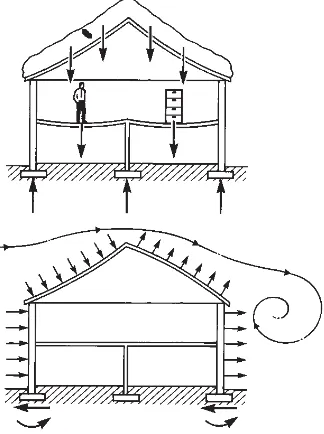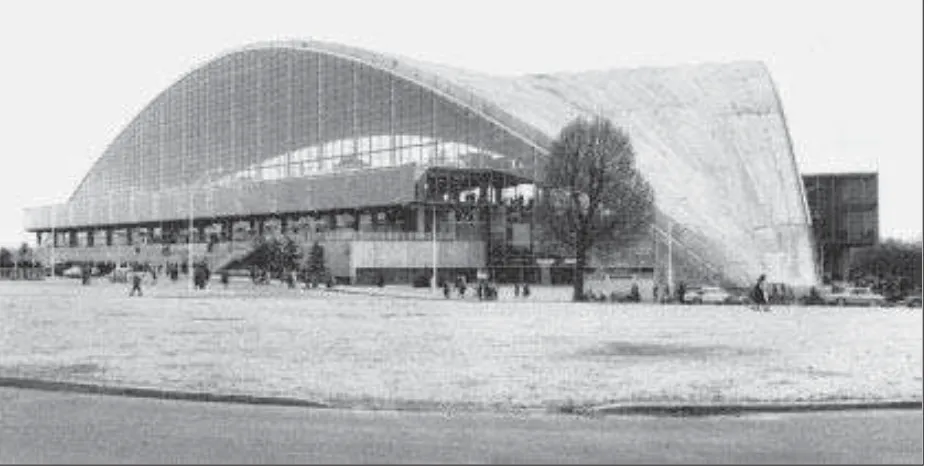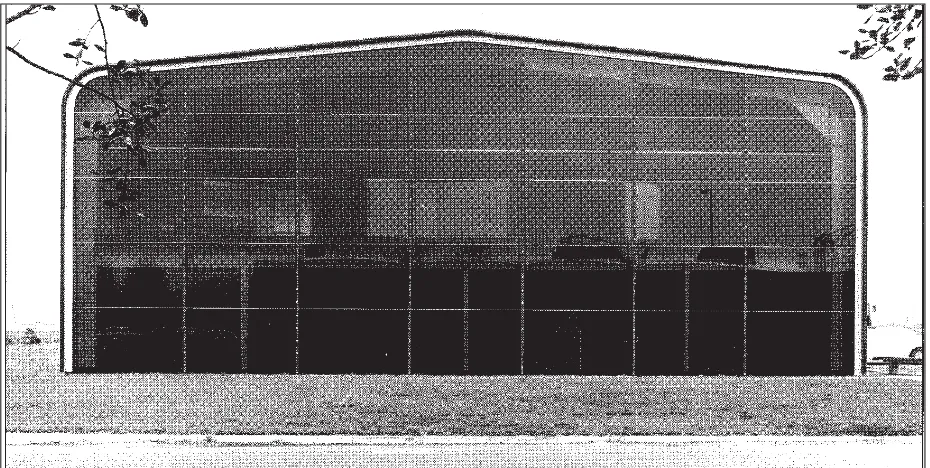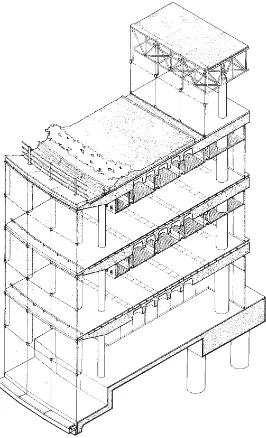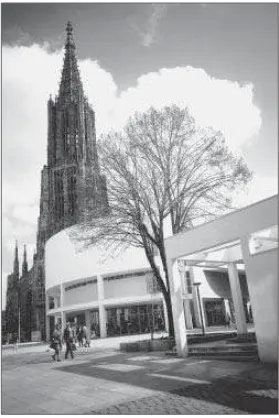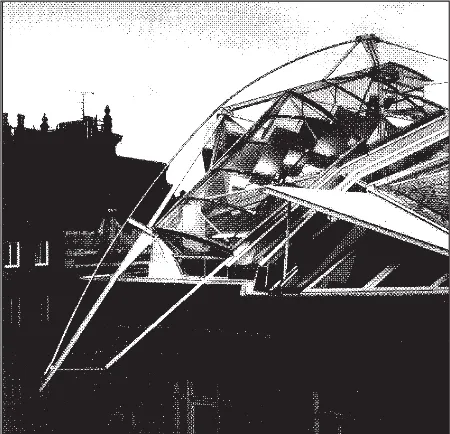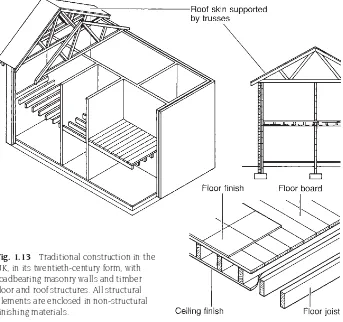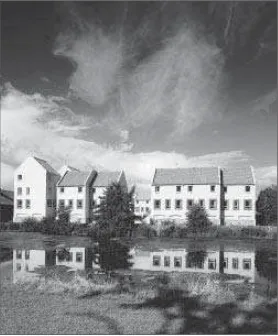The simplest way of describing the function of an architectural structure is to say that it is the part of a building which resists the loads that are imposed on it. A building may be regarded as simply an envelope which encloses and subdivides space in order to create a protected environment. The surfaces which form the envelope, that is the walls, the floors and the roof of the building, are subjected to various types of loading: external surfaces are exposed to the climatic loads of snow, wind and rain; floors are subjected to the gravitational loads of the occupants and their effects; and most of the surfaces also have to carry their own weight (Fig. 1.1). All of these loads tend to distort the building envelope and to cause it to
collapse; it is to prevent this from happening that a structure is provided. The function of a structure may be summed up, therefore, as being to supply the strength and rigidity which are required to prevent a building from
collapsing. More precisely, it is the part of a building which conducts the loads which are imposed on it from the points where they arise to the ground underneath the building, where they can ultimately be resisted.
The location of the structure within a building is not always obvious because the structure can be integrated with the non-structural parts in various ways. Sometimes, as in the simple example of an igloo (Fig. 1.2), in which ice blocks form a self-supporting protective dome, the structure and the space enclosing elements are one and the same thing. Sometimes the structural and space-enclosing elements are entirely separate. A very simple example is the tepee (Fig. 1.3), in which the protecting envelope is a skin of fabric or hide which has insufficient rigidity to form an enclosure by itself and which is supported on a framework of timber poles. Complete separation of structure and envelope occurs here: the envelope is entirely non-structural and the poles have a purely structural function.
The CNIT exhibition Hall in Paris (Fig. 1.4) is a sophisticated version of the igloo; the
reinforced concrete shell which forms the main element of this enclosure is self-supporting and, therefore, structural. Separation of skin and structure occurs in the transparent walls, however, where the glass envelope is
supported on a structure of mullions. The chapel by Le Corbusier at Ronchamp (see Fig.
7.40) is a similar example. The highly 1
The relationship of
structure to building
sculptured walls and roof of this building are made from a combination of masonry and reinforced concrete and are self-supporting. They are at the same time the elements which define the enclosure and the structural
elements which give it the ability to maintain its form and resist load. The very large ice hockey arena at Yale by Saarinen (see Fig. 7.18) is yet another similar example. Here the
building envelope consists of a network of steel cables which are suspended between three reinforced concrete arches, one in the vertical plane forming the spine of the building and two side arches almost in the horizontal plane. The composition of this building is more complex than in the previous cases because the suspended envelope can be broken down into the cable network, which has a purely structural function, and a
non-structural cladding system. It might also be argued that the arches have a purely structural function and do not contribute directly to the enclosure of space.
The steel-frame warehouse by Foster Associates at Thamesmead, UK (Fig. 1.5), is almost a direct equivalent of the tepee. The elements which form it are either purely structural or entirely non-structural because
2
Fig. 1.2 The igloo is a self-supporting compressive envelope.
Fig. 1.3 In the tepee a non-structural skin is supported on a structural framework of timber poles.
the corrugated sheet metal skin is entirely supported by the steel frame, which has a purely structural function. A similar breakdown may be seen in later buildings by the same architects, such as the Sainsbury Centre for the Visual Arts at Norwich and the warehouse and showroom for the Renault car company at Swindon (see Fig. 3.19).
In most buildings the relationship between the envelope and the structure is more
complicated than in the above examples, and frequently this is because the interior of the building is subdivided to a greater extent by internal walls and floors. For instance, in Foster Associates’ building for Willis, Faber
and Dumas, Ipswich, UK (Figs 1.6 and 7.37), 3
the reinforced concrete structure of floor slabs and columns may be thought of as having a dual function. The columns are purely structural, although they do punctuate the interior spaces and are space-dividing
elements, to some extent. The floors are both structural and space-dividing elements. Here, however, the situation is complicated by the fact that the structural floor slabs are topped by non-structural floor finishing materials and have ceilings suspended underneath them. The floor finishes and ceilings could be regarded as the true space-defining elements and the slab itself as having a purely structural function. The glass walls of the building are entirely non-structural and have a space-enclosing function only. The more recent Carré d’Art building in Nîmes (Fig. 1.7), also by Foster Associates, has a similar disposition of parts. As at Willis, Faber and Dumas a multi-storey reinforced concrete structure supports an external non-loadbearing skin.
4
Fig. 1.6 Willis, Faber and Dumas Office, Ipswich, UK, 1974; Foster Associates, architects; Anthony Hunt Associates, structural engineers. The basic structure of this building is a series of reinforced concrete coffered slab floors supported on a grid of columns. The external walls are of glass and are non-structural. In the finished building the floor slabs are visible only at the perimeter. Elsewhere they are concealed by floor finishes and a false ceiling.
The Antigone building at Montpellier by Ricardo Bofill (Fig. 1.8) is also supported by a multi-storey reinforced concrete framework. The facade here consists of a mixture of in situ and pre-cast concrete elements, and this, like the glass walls of the Willis, Faber and Dumas building, relies on a structural framework of columns and floor slabs for support. Although this building appears to be much more solid than those with fully glazed external walls it was constructed in a similar way. The Ulm Exhibition and Assembly Building by Richard Meier (Fig. 1.9) is also supported by a
reinforced concrete structure. Here the structural continuity (see Appendix 3) and
mouldability which concrete offers were exploited to create a complex juxtaposition of solid and void. The building is of the same basic type as those by Foster and Bofill however; a structural framework of reinforced concrete supports cladding elements which are non-structural.
In the Centre Pompidou in Paris by Piano and Rogers, a multi-storey steel framework is used to support reinforced concrete floors and
non-loadbearing glass walls. The breakdown of 5
Fig. 1.8 Antigone, Montpellier, France, 1983; Ricardo Bofill, architect. This building is supported by a reinforced concrete framework. The exterior walls are a combination ofin situand pre-cast concrete. They carry their own weight but rely on the interior framework for lateral support. (Photo: A. Macdonald)
parts is straightforward (Fig. 1.10): identical plane-frames, consisting of long steel columns which rise through the entire height of the building supporting triangulated girders at each floor level, are placed parallel to each other to form a rectangular plan. The concrete floors span between the triangulated girders. Additional small cast-steel girders project beyond the line of columns (Fig. 7.7) and are used to support stairs, escalators and servicing
components positioned along the sides of the building outside the glass wall, which is attached to the frame near the columns. A system of cross-bracing on the sides of the framework prevents it from collapsing through instability.
The controlled disorder of the rooftop office extension in Vienna by Coop Himmelblau (Fig. 1.11) is in some respects a complete contrast to the controlled order of the Centre
Pompidou. Architecturally it is quite different, expressing chaos rather than order, but structurally it is similar as the light external envelope is supported on a skeletal metal framework.
The house with masonry walls and timber floor and roof structures is a traditional form of building in most parts of the world. It is found in many forms, from the historic grand houses of the European landed aristocracy (Fig. 1.12) to modern homes in the UK (Figs 1.13 and 1.14). Even the simplest versions of this form of masonry and timber building (Fig. 1.13) are fairly complex assemblies of elements. Initial
Fig. 1.10 Centre Pompidou, Paris, France, 1977; Piano & Rogers, architects; Ove Arup & Partners, structural engineers. The separation of structural and enclosing functions into distinct elements is obvious here. (Photo: A. Macdonald)
Fig. 1.11 Rooftop office in Vienna, Austria, 1988; Coop Himmelblau, architects. The forms chosen here have no structural logic and were determined with almost no consideration for technical requirements. This approach design is quite feasible in the present day so long as the building is not too large.
7
Fig. 1.12 Château de Chambord, France, 1519–47. One of the grandest domestic buildings in Europe, the Château de Chambord has a loadbearing masonry structure. Most of the walls are structural; the floors are either of timber or vaulted masonry and the roof structure is of timber. (Photo: P. & A. Macdonald)
consideration could result in a straightforward breakdown of parts with the masonry walls and timber floors being regarded as having both structural and space-dividing functions and the roof as consisting of a combination of the purely supportive trusses, which are the structural elements, and the purely protective, non-structural skin. Closer examination would reveal that most of the major elements can in fact be subdivided into parts which are either purely structural or entirely non-structural. The floors, for example, normally consist of an inner core of timber joists and floor boarding, which are the structural elements, enclosed by ceiling and floor finishes. The latter are the non-structural
elements which are seen to divide the space. A similar breakdown is possible for the walls and in fact very little of what is visible in the traditional house is structural, as most of the structural elements are covered by non-structural finishes.
To sum up, these few examples of very different building types demonstrate that all buildings contain a structure, the function of which is to support the building envelope by conducting the forces which are applied to it from the points where they arise in the building to the ground below it where they are ultimately resisted. Sometimes the structure is indistinguishable from the enclosing and space-dividing building envelope, sometimes it is entirely separate from it; most often there is a mixture of elements with structural, non-structural and combined functions. In all cases the form of the structure is very closely related to that of the building taken as a whole and the
elegance with which the structure fulfils its function is something which affects the quality of the architecture.
8
